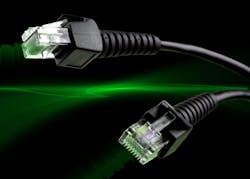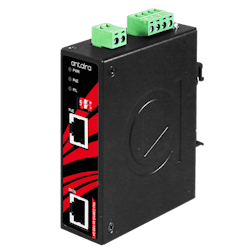How PoE Injectors Enable Industrial Plug-and-Play
Power over Ethernet (PoE) LAN switches supply dc power to PoE powered devices over long distances while transmitting data over the same Cat. 5 or higher cable. Managed or unmanaged, PoE LAN switches provide several important advantages to network administrators. For example, since they don’t have to be plugged into electrical outlets, PoE-connected devices can be positioned in optimal locations during network expansions and be repositioned when needed.
The latest version of the Institute of Electrical and Electronics Engineers (IEEE) PoE standard, known as 802.3bt, increases maximum power to 90W per switch port, opening the door to powering devices such as LED lighting, sensors, alarm systems, IP PTZ cameras and monitors, and even air conditioners.
Considering many non-PoE network switches remain in existing networks, what do you do if you want to add a PoE-enabled device to a legacy Ethernet switch on your network that is not PoE-enabled?
• Ethernet cables connect the LAN switch to the PoE device, reducing complexities in cabling in industries where deployment must be fast and reliable.
• They eliminate the extra cost of expensive power cabling and the need for separate ac/dc power supplies dedicated only to powering cables.
• They reduce the need for bulkier cabling infrastructure.
• PoE injectors come in various power configurations, making it easier to power devices with varying power needs.
What are PoE injectors?
Martel says PoE injectors connect a non-PoE switch to PoE-compliant devices. “It does this by adding power to an Ethernet cable so that any IEEE 802.3af, IEEE 802.3at and IEEE 802.3bt device connected can be powered,” he says. “Also known as midspans or PoE adapters, PoE injectors are typically used with low-power devices (30W) installed in hard-to-reach places where no power outlets are available, although newer industrial injectors can deliver much higher wattages up to 95W through multiple ports.”
Since many injectors are installed outdoors or in factories, environmentally hardened features—such as IP30 housings, wide temperature ranges, resistance to shock, EMC and vibrations, lightning protection, overload protection and redundant power inputs—are often added to support zero downtime applications.
“PoE injectors integrate easily with existing network switches,” says Martel. “Mounted on a wall or DIN rail, the injector sits between the non-PoE LAN switch and the PoE-complaint device. The injector is networked to both the switch and the device via Ethernet cables and is powered separately by a local ac outlet that it automatically converts to dc.”
Antaira Technologies offers the INJ-C201G-bt-100-24-T, an industrial Gigabit enhanced PoE++ injector. According to the company, this PoE injector ensures 90W PoE output for factory automation applications. It also supports Enhanced PoE mode to supply up to 100W to the powered device, as well as a Power Booster for low-voltage power inputs. The INJ-C201G-bt-100-24-T has a fan-less design, a temperature range of -40 °C to 75 °C, redundant 9 to 55V dc power inputs and an IP30 rating.
Cabling, safety and voltage
According to IEEE PoE standards, the cabling requirements for the PoE injectors vary with each standard. For example, the IEEE 802.3af standard allows a maximum of 15.4 Watts of power to be delivered, corresponding to Cat. 3, Cat. 5 or higher cables. IEEE standards of 802.3at use Cat. 5 cable, while 802.3bt Type 3 and 802.3bt Type 4 use Cat. 6 or higher cables due to increased heat and power transmissions.
Martel says all IEEE 802.3af/at/bt compliant PoE injectors are engineered to prevent damage to a device even if that device is not designed for PoE.
“Once plugged in, a handshake procedure will be initiated by the injector before it sends power to the connected device,” he says. “That procedure uses low voltage and is harmless to any connected device—PoE or non-PoE. Once the handshake is completed successfully, the PoE injector sends power and triggers the connected device to start up. If the handshake is not completed for any reason, the injector will not send power, therefore preventing damage.”
To avoid overloads or operating issues, the PoE-enabled device needs to be compliant with the voltage supplied by the PoE injector.
Active vs. passive injectors
“There are critical differences between an active PoE injector and a passive PoE injector,” says Martel. “An active PoE injector, once connected, establishes the handshake with the PoE device and, upon success, powers up the device. An active PoE injector will first determine the characteristics of the incoming current flow. After that, it matches the flow with the requirements of the device itself. If it senses any discrepancy in current flow, it simply won't flow the current to the device. This eliminates the risk of burning out the device.”
Active PoE injectors follow IEEE 802.3af, IEEE 802.3at, and IEEE 802.3bt standards, whereas passive PoE injectors do not. “A passive injector does not perform a handshake function,” says Martel. “It will send raw unnegotiated energy down Ethernet cables to connected devices, whether they are able to handle it or not. This is why Passive PoE is dubbed as ‘always on.’ To mitigate the risk of Passive PoEs, always make sure you are connecting the device to the exact voltage the device requires.”
When using a PoE injector to power devices, an active PoE injector is recommended to deliver power.



